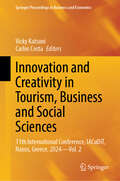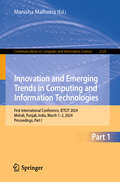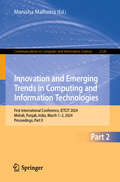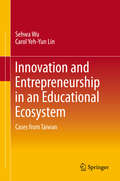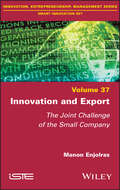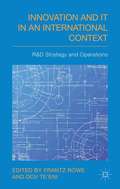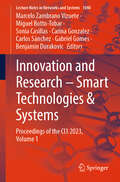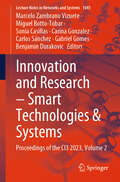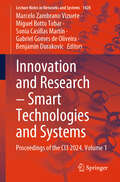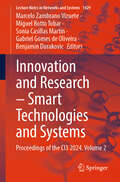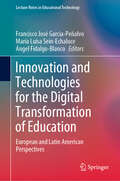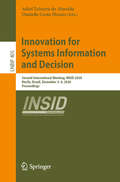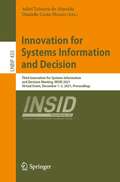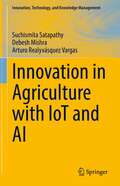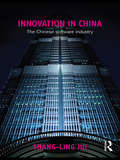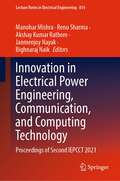- Table View
- List View
Innovation and Creativity in Tourism, Business and Social Sciences: 11th International Conference, IACuDiT, Naxos, Greece, 2024 - Vol. 2 (Springer Proceedings in Business and Economics)
by Carlos Costa Vicky KatsoniThis book is the second volume of the proceedings of the 11th International Conference of the International Association of Cultural and Digital Tourism (IACuDiT). Focusing on &“Innovation and Creativity in Tourism, Business and Social Sciences,&” the conference was held from September 3 to 5, 2024, in Naxos, Greece. The book showcases the latest research on tourism business, technology, and the social sciences and presents a critical academic discourse on ICT adoption in the social sciences, regional development; sustainability and tourism experience; smart and sustainable practices; innovations in museum interpretation and collections management; emerging and disruptive technologies; gaming, gamification and augmented reality, and other topical aspects in business and the social sciences. The book discusses these digital transformation processes from various standpoints, including its effect on the social sciences combined with specific forms of tourism. The impact of digitalization encourages the emergence of new digital products and services based on the principle of flexibility. The book focuses on the knowledge economy and the &“smart destinations&” concepts and highlights new modes of tourism management and development, while further chapters address emerging technologies, such as the Internet of Things, AI, big data, and robotics in a range of tourism practices.
Innovation and Economic Development: A Microeconomic Perspective (Routledge Studies in the Economics of Innovation)
by Jon-Arild JohannessenMicroeconomic theorists have largely excluded entrepreneurship and innovation from their theoretical analyses and models. In the existing literature, innovative entrepreneurs are hardly mentioned at all, yet it is precisely these entrepreneurs who, through their establishment of innovation-based start-ups, for example, start-ups based on technological innovations, create economic growth and help promote prosperity worldwide. The most recent examples from the digital revolution alone, such as Microsoft, Apple, and TikTok, speak to the importance of innovative entrepreneurship. This book addresses the lack of microeconomic theory concerning the role of innovation as a driver for economic development and explores the topic from multiple perspectives: innovative entrepreneurship, competence, productivity, automation, and the institutional framework.By analysing these five pillars, the book provides a broad idea of how these interactions all impact how the innovation economy continues to thrive. The book also describes the application of theory to real life by providing practical and real-life examples and case studies. It demonstrates the need to foster the spirit of innovation and entrepreneurship for sustainable development as a key driver of uninterrupted industrial development. It also highlights the critical gap in conventional economic models, which reduce everything to a single number and fail to analyse how innovation shapes both economic structures and the education systems and policies needed to adapt to them. By incorporating systems thinking and evolutionary economics, the book offers a multidimensional analysis of the innovation economy.This broad perspective enhances its theoretical depth and widens its appeal to scholars and researchers across various disciplines. Its practical approach also makes the book relevant to policymakers, educators, and practitioners.
Innovation and Emerging Trends in Computing and Information Technologies: First International Conference, IETCIT 2024, Mohali, Punjab, India, March 1–2, 2024, Proceedings, Part I (Communications in Computer and Information Science #2125)
by Manisha MalhotraThis book constitutes the proceedings of the First International Conference on Innovation and Emerging Trends in Computing and Information Technologies, IETCIT 2024, held in Mohali, India, in March 1–2, 2024. The 44 full papers presented in these two volumes were carefully reviewed and selected from 417 submissions. The papers are organized in the following topical sections: Part I: machine learning and deep learning; pattern and speech recognition; internet of things (IoT). Part II: data science and data analytics; communication, network and security.
Innovation and Emerging Trends in Computing and Information Technologies: First International Conference, IETCIT 2024, Mohali, Punjab, India, March 1–2, 2024, Proceedings, Part II (Communications in Computer and Information Science #2126)
by Manisha MalhotraThis book constitutes the proceedings of the First International Conference on Innovation and Emerging Trends in Computing and Information Technologies, IETCIT 2024, held in Mohali, India, in March 1–2, 2024. The 44 full papers presented in these two volumes were carefully reviewed and selected from 417 submissions. The papers are organized in the following topical sections: Part I: machine learning and deep learning; pattern and speech recognition; internet of things (IoT). Part II: data science and data analytics; communication, network and security.
Innovation and Entrepreneurship in an Educational Ecosystem: Cases from Taiwan
by Carol Yeh-Yun Lin Sehwa WuThis book reports on 12 education innovation cases in Taiwan and focus particularly on an ecosystem to demonstrate innovation as a competitive advantage and requires an ecosystem to be sustainable in virtually all disciplines. It also covers the trend of education innovation in many countries, with “education entrepreneurship” being the frequently used description. The 12 educators highlighted here are even more entrepreneurial than many businesspeople. Generally, schools are required to follow certain rules, especially the public schools. Accordingly, the book also describes how these education entrepreneurs have innovatively created a fostering environment under challenging constraints to facilitate the success of students, teachers, and even the local community. Six of the cases involve school-based innovation, while the other six focus on student-based innovation. Their stories provide valuable insights for all companies seeking to become more innovative in a resource-constrained setting.
Innovation and Export: The Joint Challenge of the Small Company
by Manon EnjolrasThe concepts of innovation and export are traditionally considered in isolation, both within companies and within the support organizations dedicated to them. As a result, within this broad research field, very little academic work has focused on how to implement their relationship at an operational level. This book proposes a joint diagnostic tool for SMEs, highlighting good practices to be mastered in order to simultaneously improve innovation and export performance, in the form of a virtuous circle. Innovation and Export focuses on the integration of innovation and export into the strategic management of SMEs, for which the use of synergies is a powerful lever to overcome any difficulties in mobilizing significant resources.
Innovation and Future of Enterprise Information Systems: ERP Future 2012 Conference, Salzburg, Austria, November 2012, Revised Papers
by Michael Felderer Felix PiazoloThis volume presents the revised and peer reviewed contributions of the "ERP Future 2012" conference held in Salzburg/Austria on November 11th - 12th, 2012 . The conference is a platform for research in ERP systems and closely related topics like business processes, business intelligence, and enterprise information systems in general. To master the challenges of ERP comprehensively, the ERP Future 2012 Research conference accepted contributions both with a business focus as well as with an IT focus to consider enterprise resource planning from various viewpoints. This combination of business and IT aspects is a unique characteristic of the conference and of this volume that resulted in valuable contributions with high practical impact.
Innovation and IT in an International Context
by Frantz Rowe Dov Te�eniInnovation and IT are intertwined. In order to understand how, Innovation and IT in an International Context takes an interdisciplinary view of innovation in an international and digital world. It addresses strategic and operational aspects of R&D and new product development, emphasizing knowledge management, configurational design, distance and diversity. From an economics and strategic management perspective, its first chapters deal with degree of openness, distance and specialization, and examine innovative performance in terms of patents, mergers and acquisition and exports. The second section takes a configurational approach, either at a theoretical level for general design, or in a managerial way for implementing Product Lifecycle Management systems. It also treats coordination and productivity issues. In the third part, which considers the operational level, the issues of diversity and distance are addressed more specifically and in an international context.
Innovation and Research - A Driving Force for Socio-Econo-Technological Development: Proceedings of the CI3 2021 (Lecture Notes in Networks and Systems #511)
by Miguel Botto-Tobar Marcelo Zambrano Vizuete Benjamin Durakovic Angela Diaz CadenaThis book presents the proceedings of the 2nd International Congress on Innovation and Research—A Driving Force for Socio-Econo-Technological Development (CI3 2021). CI3 was held on September 1–3, 2021. It was organized by the Instituto Tecnológico Superior Rumiñahui and GDEON, in co-organization with Higher Institutes: Bolivariano de Tecnología, Central Técnico, Espíritu Santo, José Chiriboga Grijalva, ISMAC, Policía Nacional del Ecuador Vida Nueva; and sponsored by the Universidad Nacional Mayor de San Marcos (Peru), Universidade Federal de Goiás (Brazil) and City University of New York (United States). CI3 aims to disseminate the research project results that are being carried out in different Higher Education Institutions, research centers, and the business sector.
Innovation and Research – Smart Technologies & Systems: Proceedings of the CI3 2023, Volume 1 (Lecture Notes in Networks and Systems #1040)
by Miguel Botto-Tobar Marcelo Zambrano Vizuete Benjamin Durakovic Carlos Sánchez Sonia Casillas Carina Gonzalez Gabriel GomesThis book gathers research papers presented at the 4th edition of the International Research and Innovation Conference—CI3 2023, that took place from August 30 to September 1, 2023, at the facilities of the Instituto Tecnológico Universitario Rumiñahui, located in the city of SangolquÍ, Pichincha, Ecuador. The conference was organized by the Red de Investigación, Innovación y Transferencia de Tecnología—RIT2, made up of the most relevant university institutes in Ecuador, among which are ITCA, BOLIVARIANO, ARGOS, VIDA NUEVA, ESPÍRITU SANTO, SUDAMERICANO, ISMAC, SAN ISIDRO, ARTES GRÁFICAS, ORIENTE, HUMANE, SUCRE, CENTRAL TÉCNICO, POLICÍA NACIONAL and RUMIÑAHUI. Additionally, the event is sponsored by the Secretaría de Educación Superior, Ciencia, Tecnología e Innovación—SENESCYT, Labortorio de Comunicación Visual de la Universidad Estatal de Campinas—Brazil, Universidad Ana G. Méndez—Puerto Rico, Centro de Investigaciones Psicopedagógicas y Sociológicas—Cuba, Instituto Superior de Diseño de la Universidad de La Habana—Cuba, GDEON and the Corporación Ecuatoriana para el Desarrollo de la Investigación y la Academia—CEDIA. The main objective of CI3 2023 is to generate a space for dissemination and collaboration, where academia, industry and government can share their ideas, experiences and results of their projects and research. “Research as a pillar of higher education and business improvement” is the motto of the Conference and suggests how research, innovation and academia must coincide with the productive sector to leverage social and economic development. CI3 2023 had 145 papers submitted, of which 52 were accepted for publication and presentation. To guarantee the quality of the publications, the event has a staff of more than 70 experts, from different countries such as Spain, Argentina, Chile, Mexico, Peru, Brazil, Ecuador, among others, who carry out an exhaustive review of each proposal sent. The content of this proceeding is related to the following topics: • Smart Cities • Innovation and Development • Applied Technologies • Economics and Management • ICT for Educations
Innovation and Research – Smart Technologies & Systems: Proceedings of the CI3 2023, Volume 2 (Lecture Notes in Networks and Systems #1041)
by Miguel Botto-Tobar Marcelo Zambrano Vizuete Benjamin Durakovic Carlos Sánchez Sonia Casillas Carina Gonzalez Gabriel GomesThis book gathers research papers presented at the 4th edition of the International Research and Innovation Conference—CI3 2023, that took place from August 30 to September 1, 2023, at the facilities of the Instituto Tecnológico Universitario Rumiñahui, located in the city of SangolquÍ, Pichincha, Ecuador. The conference was organized by the Red de Investigación, Innovación y Transferencia de Tecnología—RIT2, made up of the most relevant university institutes in Ecuador, among which are ITCA, BOLIVARIANO, ARGOS, VIDA NUEVA, ESPÍRITU SANTO, SUDAMERICANO, ISMAC, SAN ISIDRO, ARTES GRÁFICAS, ORIENTE, HUMANE, SUCRE, CENTRAL TÉCNICO, POLICÍA NACIONAL and RUMIÑAHUI. Additionally, the event is sponsored by the Secretaría de Educación Superior, Ciencia, Tecnología e Innovación—SENESCYT, Labortorio de Comunicación Visual de la Universidad Estatal de Campinas—Brazil, Universidad Ana G. Méndez—Puerto Rico, Centro de Investigaciones Psicopedagógicas y Sociológicas—Cuba, Instituto Superior de Diseño de la Universidad de La Habana—Cuba, GDEON and the Corporación Ecuatoriana para el Desarrollo de la Investigación y la Academia—CEDIA. The main objective of CI3 2023 is to generate a space for dissemination and collaboration, where academia, industry and government can share their ideas, experiences and results of their projects and research. “Research as a pillar of higher education and business improvement” is the motto of the Conference and suggests how research, innovation and academia must coincide with the productive sector to leverage social and economic development. CI3 2023 had 145 papers submitted, of which 52 were accepted for publication and presentation. To guarantee the quality of the publications, the event has a staff of more than 70 experts, from different countries such as Spain, Argentina, Chile, Mexico, Peru, Brazil, Ecuador, among others, who carry out an exhaustive review of each proposal sent. The content of this proceeding is related to the following topics: • Smart Cities • Innovation and Development • Applied Technologies • Economics and Management • ICT for Educations
Innovation and Research – Smart Technologies and Systems: Proceedings of the CI3 2024, Volume 1 (Lecture Notes in Networks and Systems #1428)
by Marcelo Zambrano Vizuete Benjamin Durakovic Miguel Botto Tobar Gabriel Gomes de Oliveira Sonia Casillas MartínThis book brings together the research papers presented at the 5th International Conference on Smart Technologies and Systems (CI3 2024). The conference was organized by the Red de Investigación, Innovación y Transferencia Tecnológica (RIT2), made up of the most relevant university institutes in Ecuador, including: AMERICAN COLLEGE, ARGOS, BOLIVARIANO, CENTRAL TÉCNICO, CORDILLERA, ESPÍRITU SANTO, ISMAC, ITCA, HUMANE, ORIENTE, POLICIA NACIONAL, RUMIÑAHUI, SAN ISIDRO, SUCRE, SUDAMERICANO, TECNOLÓGICO DEL AZUAY and VIDA NUEVA. Additionally, it was sponsored by the Secretaría de Educación Superior, Ciencia, Tecnología e Innovación (SENESCYT), the Corporación Ecuatoriana para el Desarrollo de la Investigación y la Academia (CEDIA), the Laboratório de Comunicações Visuais of Campinas University (Brazil), Ana G. Méndez University (Puerto Rico), the Centro de Investigaciones Psicopedagógicas y Sociológicas (Cuba) and the Instituto Superior de Diseño de la Universidad de La Habana (Cuba).
Innovation and Research – Smart Technologies and Systems: Proceedings of the CI3 2024, Volume 2 (Lecture Notes in Networks and Systems #1429)
by Marcelo Zambrano Vizuete Benjamin Durakovic Miguel Botto Tobar Gabriel Gomes de Oliveira Sonia Casillas MartínThis book brings together the research papers presented at the 5th International Conference on Smart Technologies and Systems (CI3 2024). The conference was organized by the Red de Investigación, Innovación y Transferencia Tecnológica (RIT2), made up of the most relevant university institutes in Ecuador, including: AMERICAN COLLEGE, ARGOS, BOLIVARIANO, CENTRAL TÉCNICO, CORDILLERA, ESPÍRITU SANTO, ISMAC, ITCA, HUMANE, ORIENTE, POLICIA NACIONAL, RUMIÑAHUI, SAN ISIDRO, SUCRE, SUDAMERICANO, TECNOLÓGICO DEL AZUAY and VIDA NUEVA. Additionally, it was sponsored by the Secretaría de Educación Superior, Ciencia, Tecnología e Innovación (SENESCYT), the Corporación Ecuatoriana para el Desarrollo de la Investigación y la Academia (CEDIA), the Laboratório de Comunicações Visuais of Campinas University (Brazil), Ana G. Méndez University (Puerto Rico), the Centro de Investigaciones Psicopedagógicas y Sociológicas (Cuba) and the Instituto Superior de Diseño de la Universidad de La Habana (Cuba).
Innovation and Research: A Driving Force for Socio-Econo-Technological Development (Advances in Intelligent Systems and Computing #1277)
by Miguel Botto-Tobar Angela Díaz Cadena Marcelo Zambrano VizueteThis book presents the proceedings of the 1st International Congress on Innovation and Research – A Driving Force for Socio-Econo-Technological Development (CI3 2020). CI3 was held on June 18–19, 2020. It was organized by the Instituto Tecnológico Superior Rumiñahui and GDEON, in co-organization with Higher Institutes: Libertad, Bolivariano, Vida Nueva, Espíritu Santo, Sudamericano Loja, Central Técnico and sponsored by the Universidad Nacional Mayor de San Marcos (Perú), the Federal University of Goiás (Brazil) and HOSTOS—Community University of New York (USA). CI3 aims to promote the development of research activities in Higher Education Institutions and the relationship between the productive and scientific sector of Ecuador, supporting the fulfilment of the National Development Plan “Toda una vida 2017-2021”.
Innovation and Technologies for the Digital Transformation of Education: European and Latin American Perspectives (Lecture Notes in Educational Technology)
by Francisco José García-Peñalvo María Luisa Sein-Echaluce Ángel Fidalgo-BlancoThis book provides a critical overview of the current use of learning technologies for educational innovation and examines global trends in educational innovation. It also shares experiences in educational innovation with learning technologies in Europe and Latin America. Despite increasing concerns about the use of technology in education, this book discusses how these can be addressed by focusing on fundamental principles such as personalization, collaboration, engagement, accessibility, and professional development.
Innovation for Systems Information and Decision: Second International Meeting, INSID 2020, Recife, Brazil, December 2–4, 2020, Proceedings (Lecture Notes in Business Information Processing #405)
by Adiel Teixeira de Almeida Danielle Costa MoraisThis book constitutes the refereed proceedings of the Second International Meeting on Innovation for Systems Information and Decision meeting, INSID 2020, held in Recife, Brazil, in December 2020. Due to the COVID-19 pandemic the conference was held virtually. The 8 papers presented in this volume were carefully reviewed and selected from a total of 84 submissions to the main conference. The selected papers reflect methodological improvements and advances in Multicriteria Decision-Making/Multicriteria Decision-Aid (MCDM/MCDA) oriented toward real-world applications and contribute to the understanding of relevant developments of current research on and future trends of Innovation for Systems Information and Decision.
Innovation for Systems Information and Decision: Third Innovation for Systems Information and Decision Meeting, INSID 2021, Virtual Event, December 1–3, 2021, Proceedings (Lecture Notes in Business Information Processing #435)
by Adiel Teixeira de Almeida Danielle Costa MoraisThis book constitutes the refereed proceedings of the Third International Meeting on Innovation for Systems Information and Decision, INSID 2021, which was held during December 1-3, 2021. The conference was initially planned to take place in Recife, Brazil, but changed to a virtual meeting due to the COVID-19 pandemic. The 9 full papers presented in this volume were carefully reviewed and selected from a total of 76 submissions. They reflect methodological improvements and advances in multi-criteria decision-making/multi-criteria decision-aid (MCDM/MCDA) oriented toward real-world applications, which contribute to the understanding of relevant developments of current research on and future trends of innovation for systems information and decision.
Innovation in Agricultural Robotics for Precision Agriculture: A Roadmap for Integrating Robots in Precision Agriculture (Progress in Precision Agriculture)
by Avital BecharThis book provides a review of the state-of-the-art of agricultural robotics in different aspects of PA, the goals, and the gaps. The book introduces the area of Agricultural Robotics for Precision Agriculture (PA) specifically the conditions and limitations for implementing robots in this field and presents the concepts, principles, required abilities, components, characteristics and performance measures, conditions, and rules for robots in PA.
Innovation in Agriculture with IoT and AI (Innovation, Technology, and Knowledge Management)
by Arturo Realyvásquez Vargas Suchismita Satapathy Debesh MishraThis book examines different innovations in worldwide agricultural-systems including the applications of artificial intelligence (AI), internet of things (IoT) and features of machine learning (ML) for the benefits of the farm-community. Specifically, it examines the use of agricultural equipment and IoT to reduce physical stress; innovative equipment that measure and reduce mental work load; and innovative techniques to help with employee safety. Featuring case studies and future implications, this book is an excellent guide for academics and researchers in the agri-sector.
Innovation in China: The Chinese Software Industry (Routledge Contemporary China Series)
by Shang-Ling JuiA key question for China, which has for some time been a leading global manufacturing base, is whether China can progress from being a traditional centre of manufacturing to becoming a centre for innovation. In this book, Shang-Ling Jui focuses on China’s software industry and examines the complete innovation value chain of software in its key phases of innovation, standards definition, development and marketing. He argues that, except for software development, these key phases are of high added-value and that without adopting the concept of independent innovation as a guiding ideology, China’s software enterprises – like India’s – would have an uncertain future. In other words, the lack of core competence in the development of China’s software industry might restrain the industry from taking the leading position and drive it towards becoming no more than the software workshop of multinationals over the long term. Shang-Ling Jui contends that China’s software industry should and can possess its own complete innovation value chain. Having worked in China’s software industry for many years, the author provides an inside-out perspective – identifying the strengths and weaknesses of the industry and defining the challenges in China’s transition from "Made in China" to "Innovated in China."
Innovation in Design, Communication and Engineering: Proceedings of the 2014 3rd International Conference on Innovation, Communication and Engineering (ICICE 2014), Guiyang, Guizhou, P.R. China, October 17-22, 2014
by Stephen D. Prior Teen-Hang Meen Artde Donald Kin-Tak LamThis volume represents the proceedings of the 2014 3rd International Conference on Innovation, Communication and Engineering (ICICE 2014). This conference was held in Guiyang, Guizhou, P.R. China, October 17-22, 2014. The conference provided a unified communication platform for researchers in a wide range of fields from information technology,
Innovation in Design, Communication and Engineering: Proceedings of the 8th Asian Conference on Innovation, Communication and Engineering (ACICE 2019), October 25-30, 2019, Zhengzhou, P.R. China (Smart Science, Design & Technology)
by Stephen D. Prior Artde Donald Kin-Tak Lam Siu-Tsen Shen Sheng-Joue Young Liang-Wen JiThis volume represents the proceedings of the 8th Asian Conference on Innovation, Communication and Engineering (ACICE 2019), which was held in P.R. China, October 25-30, 2019. The conference aimed to provide an integrated communication platform for researchers in a wide range of fields including information technology, communication science, applied mathematics, computer science, advanced material science, and engineering. The conference and resulting proceedings aim to enhance interdisciplinary collaborations between science and engineering technologists in academia and industry within this unique international network.
Innovation in Electrical Power Engineering, Communication, and Computing Technology: Proceedings of IEPCCT 2019 (Lecture Notes in Electrical Engineering #630)
by Janmenjoy Nayak Bighnaraj Naik Danilo Pelusi Renu Sharma Manohar MishraThis book features selected high-quality papers from the International Conference on Innovation in Electrical Power Engineering, Communication, and Computing Technology (IEPCCT 2019), held at Siksha 'O' Anusandhan (Deemed to be University), Bhubaneswar, India, on 13–14 December 2019. Presenting innovations in power, communication, and computing, it covers topics such as mini, micro, smart and future power grids; power system economics; energy storage systems; intelligent control; power converters; improving power quality; signal processing; sensors and actuators; image/video processing; high-performance data mining algorithms; advances in deep learning; and optimization methods.
Innovation in Electrical Power Engineering, Communication, and Computing Technology: Proceedings of Second IEPCCT 2021 (Lecture Notes in Electrical Engineering #814)
by Janmenjoy Nayak Bighnaraj Naik Renu Sharma Manohar Mishra Akshay Kumar RathoreThis book features selected high-quality papers from the Second International Conference on Innovation in Electrical Power Engineering, Communication, and Computing Technology (IEPCCT 2021), held at Siksha 'O' Anusandhan (Deemed to be University), Bhubaneswar, India, on 24–26 September 2021. Presenting innovations in power, communication, and computing, it covers topics such as mini, micro, smart and future power grids; power system economics; energy storage systems; intelligent control; power converters; improving power quality; signal processing; sensors and actuators; image/video processing; high-performance data mining algorithms; advances in deep learning; and optimization methods.
Innovation in Healthtech: A Roadmap for Empowering Healthcare (Advancing Science and Engineering through Artificial Intelligence, Machine Learning, and Mathematical Modeling)
by Rakesh Kumar Meenu GuptaSophisticated data analysis is revolutionizing healthcare decision- making, personalized treatments, and operational efficiency. Innovations in HealthTech covers this impact and highlights the significance of robust security measures in safeguarding sensitive medical data and ensuring patient confidentiality. The book provides insights into the development, implementation, and future potential of telemedicine infrastructure. Explores the role of wearable technology in promoting patient engagement and wellness and addressing the critical issue of data security. Offers practical technical insights that provide a deeper understanding of the real-world applications and challenges in the healthcare technology landscape. Examines the role of telehealth and remote monitoring in healthcare accessibility, and use of artificial intelligence in augmenting clinical decision-making processes. Discusses frameworks and guidelines that enable different health technologies and systems to work together seamlessly, ensuring efficient data exchange and improved patient care. Presents the essential measures and strategies in place to protect sensitive healthcare data, ensuring the confidentiality and integrity of information. The text is primarily written for senior undergraduates, graduate students, and academic researchers in the fields of electrical engineering, electronics and communications engineering, computer engineering, and biomedical engineering.
